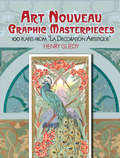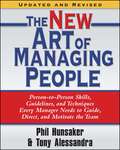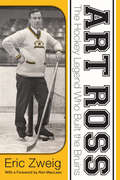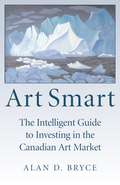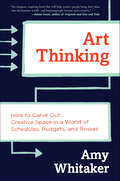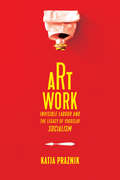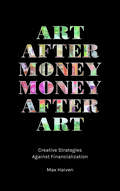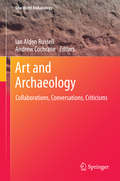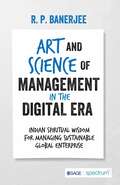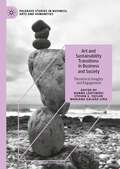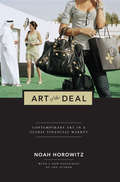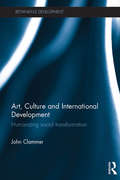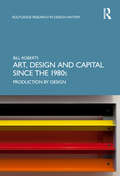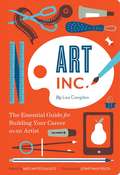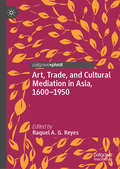- Table View
- List View
Art Nouveau Graphic Masterpieces: 100 Plates From "La Decoration Artistique" (Calla Editions)
by Henry GuedyPublished in Paris before World War I, these decorative Art Nouveau graphics originally appeared in a now-rare periodical, La Decoration Artistique. This compilation presents 100 full-color plates in a beautiful assortment of period designs that will prove essential to collectors of the era's best and hardest-to-find illustrations. A splendid variety of images includes headpieces, typographical banners, and other designs rendered in the distinctive Art Nouveau style, all embellished with naturalistic motifs, from parrots and peacocks to sinuous vines and flowers in full bloom. Other illustrations feature storefront signage for bakeries and cafés; decorative friezes of theatrical masks and grapevines; borders of blossoms, books, and birds; stenciled decorations for fire screens; and corner and ceiling ornaments. Art aficionados, designers, artists, art students, and anyone with a taste for Art Nouveau will delight in this extraordinary collection, which offers a lasting source of inspiration and pleasure.
Art Of Managing People
by Tony AlessandraThe Art of Managing People provides practical strategies, guidelines and techniques for developing an effective team of satisfied, energetic workers.
Art Ross: The Hockey Legend Who Built the Bruins
by Eric Zweig Ron MacleanThe first authorized biography of Art Ross, Hockey Hall of Famer, NHL founding father, and long-time member of the Boston Bruins. Though he last played the game nearly one hundred years ago, Art Ross remains connected with the greatest stars in hockey. Gordie Howe, Bobby Orr, Wayne Gretzky, and Sidney Crosby have all won the award that bears his name, the trophy given annually to the NHL’s top scorer. Ross himself managed just one goal during his NHL career; however, in the dozen years leading up to the formation of the NHL in 1917, he was one of the biggest stars in the game. After his playing career ended, Ross became one of the founding fathers of the Boston Bruins, holding the positions of coach, general manager, and vice president. He was one of the men most responsible for making the NHL a success in the United States, and was integral to the modernization of hockey. All these accomplishments led to him being one of the first players inducted into the Hockey Hall of Fame. Hockey historian Eric Zweig brings to life the early days of hockey. From the mining towns of Northern Ontario to the hallowed halls of Boston Garden, Art Ross was one of the biggest names in hockey over his six decades in the game.
Art Smart: The Intelligent Guide to Investing in the Canadian Art Market
by Alan D. BryceArt Smart is a comprehensive guide to the Canadian art market for both novice and experienced collectors. It is full of advice that can give anyone the tools to determine the value of a piece of art and to not be intimidated by the often mystifying world of art. This informative and helpful volume covers the inner workings of the art market, from dealer trade secrets to expert strategies on buying and selling through auction houses and online. Art Smart gives the reader the knowledge needed to build a collection for long-term investment value, and also covers tax and estate planning, copyright issues, and charitable donations. It also contains all the latest resources for art research, with useful appendices to guide the art consumer in becoming their own art connoisseur. Art Smart is essential reading if you are curious to know more about how the art market functions and is an excellent resource guide for those already involved.
Art Thinking: How to Carve Out Creative Space in a World of Schedules, Budgets, and Bosses
by Amy WhitakerAn indispensable and inspiring guide to creativity in the workplace and beyond, drawing on art, psychology, science, sports, law, business, and technology to help you land big ideas in the practical world.Anyone from CEO to freelancer knows how hard it is to think big, let alone follow up, while under pressure to get things done. Art Thinking offers practical principles, inspiration, and a healthy dose of pragmatism to help you navigate the difficulties of balancing creative thinking with driving toward results.With an MBA and an MFA, Amy Whitaker, an entrepreneur-in-residence at the New Museum Incubator, draws on stories of athletes, managers, writers, scientists, entrepreneurs, and even artists to engage you in the process of “art thinking.” If you are making a work of art in any field, you aren’t going from point A to point B. You are inventing point B.Art Thinking combines the mind-sets of art and the tools of business to protect space for open-ended exploration and manage risks on your way to success. Art Thinking takes you from “Wouldn’t it be cool if . . . ?” to realizing your highest aims, helping you build creative skills you can apply across all facets of business and life. Warm, honest, and unexpected, Art Thinking will help you reimagine your work and life—and even change the world—while enjoying the journey from point A.Art Thinking features 60 line drawings throughout.
Art Work: Invisible Labour and the Legacy of Yugoslav Socialism
by Katja PraznikIn Art Work, Katja Praznik counters the Western understanding of art – as a passion for self-expression and an activity done out of love, without any concern for its financial aspects – and instead builds a case for understanding art as a form of invisible labour. Focusing on the experiences of art workers and the history of labour regulation in the arts in socialist Yugoslavia, Praznik helps elucidate the contradiction at the heart of artistic production and the origins of the mystification of art as labour. This profoundly interdisciplinary book highlights the Yugoslav socialist model of culture as the blueprint for uncovering the interconnected aesthetic and economic mechanisms at work in the exploitation of artistic labour. It also shows the historical trajectory of how policies toward art and artistic labour changed by the end of the 1980s. Calling for a fundamental rethinking of the assumptions behind Western art and exploitative labour practices across the world, Art Work will be of interest to scholars in East European studies, art theory, and cultural policy, as well as to practicing artists.
Art after Money, Money after Art: Creative Strategies against Financialization
by Max HaivenWe imagine that art and money are old enemies, but this myth actually reproduces a violent system of global capitalism and prevents us from imagining and building alternatives. From the chaos unleashed by the ‘imaginary’ money in financial markets to the new forms of exploitation enabled by the ‘creative economy’ to the way art has become the plaything of the world’s plutocrats, our era of financialization demands that we question our romantic assumptions about art and money. By exploring the way contemporary artists engage with cash, debt, and credit, Haiven identifies and assesses a range of creative strategies for mocking, sabotaging, exiting, decrypting, and hacking capitalism today. Written for artists, activists, and scholars, this book makes an urgent call to unleash the power of the radical imagination by any media necessary.
Art and Archaeology: Collaborations, Conversations, Criticisms (One World Archaeology #11)
by Ian Alden Russell Andrew CochraneThis volume presents a collection of interdisciplinary collaborations between contemporary art, heritage, anthropological, and archaeological practitioners. Departing from the proceedings of the Sixth World Archaeological Congress's 'Archaeologies of Art' theme and Ábhar agus Meon exhibitions, it includes papers by seminal figures as well as experimental work by those who are exploring the application of artistic methods and theory to the practice of archaeology. Art and archaeology: collaborations, conversations, criticisms encourages the creative interplay of various approaches to 'art' and 'archaeology' so these new modes of expression can contribute to how we understand the world. Established topics such as cave art, monumental architecture and land art will be discussed alongside contemporary video art, performance art and relational arts practices. Here, the parallel roles of artists as makers of new worlds and archaeologists as makers of pasts worlds are brought together to understand the influences of human creativity.
Art and Science of Management in Digital Era: Indian Spiritual Wisdom For Managing Sustainable Global Enterprise
by Rama Prosad BanerjeeA manager needs to perform the role of a leader, a consumer, a buyer, a maker, a worker, a messenger, an advisor and a guide to all other stakeholders in a business setting. Though the fundamentals of management are eternally same in nature, the learners and practicing managers should continuously sensitize themselves with the fundamentals in view of the changing times and circumstances. This book aims to be a guiding handbook for emerging and practicing managers in the ever-changing corporate world. Going beyond explaining just the basics of management, this book will help the readers understand the art of practicing management.
Art and Science of Management in the Digital Era: Indian Spiritual Wisdom for Managing Sustainable Global Enterprise
by R. P. BanerjeeA manager needs to perform the role of a leader, a consumer, a buyer, a maker, a worker, a messenger, an advisor and a guide to all other stakeholders in a business setting. Though the fundamentals of management are eternally same in nature, the learners and practicing managers should continuously sensitize themselves with the fundamentals in view of the changing times and circumstances. This book aims to be a guiding handbook for emerging and practicing managers in the ever-changing corporate world. Going beyond explaining just the basics of management, this book will help the readers understand the art of practicing management.
Art and Sustainability Transitions in Business and Society: Theoretical Insights and Engagement (Palgrave Studies in Business, Arts and Humanities)
by Steven S. Taylor Hanna Lehtimäki Mariana Galvão LyraAn increased understanding of art and art-based-methods is needed to address the behavioral and cultural change in the sustainability transition. This edited collection explores ways to engage people in their citizen, consumer, employer, employee and entrepreneurial roles, as they grapple with the sustainability transition. It introduces art and arts-based methods to advance sustainability thinking. As a unique contribution to sustainability research, this book presents insights from artists, art organizations and specialists using arts-based-methods in education, organizational innovation and citizen engagement. The book will provide inspiring insights to scholars and students of sustainability, innovation, corporate strategy, and creativity in business.
Art and the Global Economy
by John ZarobellArt and the Global Economy analyzes major changes in the global art world that have emerged in the last twenty years including structural shifts in the global art market; the proliferation of international art fairs, biennials and blockbuster exhibitions; and the internationalization of the scope of contemporary art. John Zarobell explores the economic and social transformations in the cultural sphere, the results of greater access to information about art, exhibitions, and markets around the world, as well as the increasing interpenetration of formerly distinct geographical domains. By considering a variety of locations—both long-standing art capitals and up-and-coming centers of the future—Art and the Global Economy facilitates a deeper understanding of how globalization affects the domain of the visual arts in the twenty-first century. With contributions by Lucia Cantero, Mariana David, Valentin Diaconov, Kai Lossgott, Grace Murray, Chhoti Rao, Emma Rogers and Michelle Wong.
Art and the Market
by Craufurd D. GoodwinRoger Fry, a core member of the Bloomsbury Group, was involved with all aspects of the art market as artist, critic, curator, historian, journalist, advisor to collectors, and gallery operator. He is especially remembered as the person who introduced postimpressionist art to Britain. Reprinted in this volume are seventeen of Fry's works on commerce in art. Although he had no formal training in economics, Fry addressed the art market as a modern economist might do. It is therefore fitting that his writings receive here an original interpretation from the perspective of a modern economist, Craufurd D. Goodwin. Goodwin explores why Fry's work is both a landmark in the history of cross-disciplinary thought and a source of fresh insights into a wide range of current policy questions. The new writings included contain Fry's most important contributions to theory, history, and debates over policy as he explored the determinants of the supply of art, the demand for art, and the art market institutions that facilitate exchange. His ideas and speculations are as stimulating and provocative today as when they were written.
Art of the Deal: Contemporary Art in a Global Financial Market
by Noah HorowitzArt today is defined by its relationship to money as never before. Prices have been driven to unprecedented heights, conventional boundaries within the art world have collapsed, and artists think ever more strategically about how to advance their careers. Art is no longer simply made, but packaged, sold, and branded. In Art of the Deal, Noah Horowitz exposes the inner workings of the contemporary art market, explaining how this unique economy came to be, how it works, and where it's headed.In a new postscript, Horowitz reflects on the evolution of the trade since the book's original release in 2011, shining light on the market's continued ascent as well as its most urgent challenges.
Art, Culture and International Development: Humanizing social transformation (Rethinking Development)
by John ClammerCulture is not simply an explanation of last resort, but is itself a rich, multifaceted and contested concept and set of practices that needs to be expanded, appreciated and applied in fresh ways if it is to be both valued in itself and to be of use in practical development. This innovative book places culture, specifically in the form of the arts, back at the centre of debates in development studies by introducing new ways of conceptualizing art in relation to development. The book shows how the arts and development are related in very practical ways – as means to achieve development goals through visual, dramatic, filmic and craft-inspired ways. It advocates not so much culture and development, but rather for the development of culture. Without a cultural content to economic and social transformation the problems found in much development – up-rooting of cultures, loss of art forms, languages and modes of expression and performance – may only accelerate. Paying attention to the development of the arts as the content of development helps to amend this culturally destructive process. Finally, the book argues for the value of the arts in attaining sustainable cultures, promoting poverty alleviation, encouraging self-empowerment, stimulating creativity and the social imagination, which in turn flow back into wider processes of social transformation. Discussion questions at the end of each chapter make this book ideal to help foster further thinking and debate. This book is an inspiring read for postgraduate students and researchers in the fields of development studies, cultural studies and sociology of development.
Art, Design and Capital since the 1980s: Production by Design (Routledge Research in Design History)
by Bill RobertsThis book examines artists’ engagements with design and architecture since the 1980s, and asks what they reveal about contemporary capitalist production and social life. Setting recent practices in historical relief, and exploring the work of Dan Graham, Rita McBride, Tobias Rehberger and Liam Gillick, Bill Roberts argues that design is a singularly valuable lens through which artists evoke, trace and critique the forces and relations of production that underpin everyday experience in advanced capitalist economies.
Art, Enterprise and Ethics: The Life and Works of William Morris
by Charles Harvey Jon Press Professor Jon PressThe life and works of William Morris continue to excite the imaginations of fresh generations of scholars working in many traditions, from the history of art and design to literary criticism and the history of socialism and socialist thought. This book concentrates on Morris's social and political acheivements as well as his artistic talents.
Art, Inc.
by Jonathan Fields Meg Mateo Ilasco Lisa CongdonArtists who dream of turning their passion into a career need only the expert guidance in Art, Inc. Lisa Congdon unveils the multiplicity of ways to make a living from art--including illustration, licensing, fine art sales, print sales, and teaching-- and offers practical advice on cultivating a business mindset, selling and promoting work, and more. Trade secrets from art world pros including such luminaries as Paula Scher, Nikki McClure, and Mark Hearld make Art, Inc. the ultimate resource for aspiring artists ready for success.
Art, Trade, and Cultural Mediation in Asia, 1600–1950
by Raquel A. ReyesThis Palgrave Pivot explores the social and cultural impact of global trade at a micro-level from around 1600 to 1950. Bringing together the collaborative skills of cultural, social, economic, and art historians, it examines how the diffusion of trade, goods and objects affected people’s everyday lives. The authors tell several stories: of the role played by a host of intermediaries – such as apothecaries, artisans and missionaries who facilitated the process; of objects such as Japanese export lacquer-ware and paintings; of how diverse artistic influences came to be expressed in colonial church architecture in the Philippines; of revolutionary changes wrought on quotidian tastes and preferences, as shown in the interior decoration of private homes in the Dutch East Indies; and of transformations in the smoking and drinking habits of Southeast Asians. The chapters consider the conditions from which emerged new forms of artistic production and transfer, fresh cultural interpretations, and expanded markets for goods, objects and images.
Artea (C): Potential Discrimination through Algorithmic Targeting
by Ayelet Israeli Eva AscarzaThis collection of exercises aims to teach students about 1)Targeting Policies; and 2)Algorithmic bias in marketing-implications, causes, and possible solutions. Part (A) focuses on A/B testing analysis and targeting. Parts (B),(C),(D) Introduce algorithmic bias. The exercises are designed such that the issues of algorithmic bias and discrimination would emerge inductively, "surprising" the students in the act of recommending a strategy that, inadvertently, is discriminating against customers who belong to minority groups. This is achieved via the combination of hands-on exercises, where students would make decisions based on data analyses and visualization, and in-class discussions, where students would defend their proposed strategies, discover the (discriminating) implications of those actions, and discuss possible solutions.
Artea (D): Discrimination through Algorithmic Bias in Targeting
by Ayelet Israeli Eva AscarzaThis collection of exercises aims to teach students about 1)Targeting Policies; and 2)Algorithmic bias in marketing-implications, causes, and possible solutions. Part (A) focuses on A/B testing analysis and targeting. Parts (B),(C),(D) Introduce algorithmic bias. The exercises are designed such that the issues of algorithmic bias and discrimination would emerge inductively, "surprising" the students in the act of recommending a strategy that, inadvertently, is discriminating against customers who belong to minority groups. This is achieved via the combination of hands-on exercises, where students would make decisions based on data analyses and visualization, and in-class discussions, where students would defend their proposed strategies, discover the (discriminating) implications of those actions, and discuss possible solutions.
Artea: Designing Targeting Strategies
by Ayelet Israeli Eva AscarzaThis collection of exercises aims to teach students about 1)Targeting Policies; and 2)Algorithmic bias in marketing-implications, causes, and possible solutions. Part (A) focuses on A/B testing analysis and targeting. Parts (B),(C),(D) Introduce algorithmic bias. The exercises are designed such that the issues of algorithmic bias and discrimination would emerge inductively, "surprising" the students in the act of recommending a strategy that, inadvertently, is discriminating against customers who belong to minority groups. This is achieved via the combination of hands-on exercises, where students would make decisions based on data analyses and visualization, and in-class discussions, where students would defend their proposed strategies, discover the (discriminating) implications of those actions, and discuss possible solutions.
Artemisia Gentileschi and the Business of Art
by Christopher R. MarshallA new account of the renowned Baroque painter, revealing how her astute professional decisions shaped her career, style, and legacyArt has long been viewed as a calling—a quasi-religious vocation that drives artists to seek answers to humanity&’s deepest questions. Yet the art world is a risky, competitive business that requires artists to make strategic decisions, especially if the artist is a woman. In Artemisia Gentileschi and the Business of Art, Christopher Marshall presents a new account of the life, work, and legacy of the Italian Baroque painter, revealing how she built a successful four-decade career in a male-dominated field—and how her business acumen has even influenced the resurrection of her reputation today, when she has been transformed from a footnote of art history to a globally famous artist and feminist icon.Combining the most recent research with detailed analyses of newly attributed paintings, the book highlights the business considerations behind Gentileschi&’s development of a trademark style as she marketed herself to the public across a range of Italian artistic centers. The disguised self-portraits in her early Florentine paintings are reevaluated as an effort to make a celebrity brand of her own image. And, challenging the common perception that Gentileschi&’s only masterpieces are her early Caravaggesque paintings, the book emphasizes the importance of her neglected late Neapolitan works, which are reinterpreted as innovative responses to the conventional practices of Baroque workshops.Artemisia Gentileschi and the Business of Art shows that Gentileschi&’s remarkable success as a painter was due not only to her enormous talent but also to her ability to respond creatively to the continuously evolving trends and challenges of the Italian Baroque art world.
Arthashastrachi Multatve Second Semester FYBA New NEP Syllabus - RTMNU: अर्थशास्त्राची मूलतत्त्वे दुसरे सत्र एफ.वाय.बी.ए. नवीन एन.इ.पी. अभ्यासक्रम - राष्ट्रसंत तुकडोजी महाराज नागपूर विद्यापीठ
by Prof. B. L. Jibhkate“अर्थशास्त्राची मूलतत्त्वे” हे प्रा. बी. एल. जिभकाटे लिखित पुस्तक बी.ए. प्रथम वर्षाच्या दुसऱ्या सत्रासाठी नवीन शैक्षणिक धोरण २०२० नुसार तयार करण्यात आले आहे. हे पुस्तक अर्थशास्त्राचे प्राथमिक पण मूलभूत पैलू सुलभ भाषेत स्पष्ट करते. पुस्तकात सूक्ष्म आणि स्थूल अर्थशास्त्राचे सिद्धांत, राष्ट्रीय उत्पन्न, मुद्रा, मागणी-पुरवठा, उपभोग, उत्पादन, बाजार, तसेच किंमतनिर्धारण इत्यादी संकल्पनांचा समावेश आहे. लेखकाने विद्यार्थ्यांना समजण्यास सोपे जावे यासाठी उदाहरणांचा वापर करून विविध व्याख्या आणि सिद्धांतांचे सुलभ विश्लेषण केले आहे. ॲडम स्मिथ, मार्शल आणि रॉबिन्स यांच्या व्याख्यांच्या तुलनात्मक अभ्यासातून अर्थशास्त्राचे स्वरूप, त्याची व्याप्ती, मर्यादा व महत्त्व समजावून सांगितले आहे. तसेच आधुनिक काळात अर्थशास्त्र हे केवळ एक शास्त्र न राहता व्यवहार व धोरणात्मक पातळीवर प्रभाव टाकणारे ज्ञानकेंद्र बनले असल्याचे दाखवून दिले आहे. सूक्ष्मदृष्टिकोनातून व्यक्ती, कुटुंब, उद्योग या घटकांचा, तर स्थूलदृष्टिकोनातून राष्ट्रीय उत्पन्न, चलनविषयक धोरण, रोजगार इत्यादी बाबींचा समावेश अभ्यासात केला जातो. विद्यार्थ्यांना परीक्षेसाठी उपयुक्त ठरेल अशी रचना असून प्रत्येक घटकाचे उपविभाग व प्रश्नसंचही समाविष्ट आहेत. त्यामुळे हे पुस्तक विद्यार्थ्यांना केवळ अभ्यासासाठी नव्हे तर विचारप्रवृत्त करणारे मार्गदर्शनही करते.
Arthat: अर्थात
by Achyut Godboleअर्थशास्त्राच्या सिध्दांतांचा आणि धोरणांचा अत्युत्कृष्ट, चित्तवेधक इतिहास आणि अर्थशास्त्रज्ञांची रंजक चरित्रं म्हणजेच 'अर्थात'! अतिशय चूकपणे आणि रसाळ शैलीत लिहिलेलं हे पुस्तक विद्यार्थी, शिक्षक आणि सर्वसामान्य वाचकांना अतिशय उपयोगी ठरेल. डॉ. भालचंद्र मुणगेकर माजी कुलगुरू, मुंबई विद्यापीठ माजी सदस्य, प्लॅनिंग कमिशन, भारत सरकार अर्थशास्त्राच्या उगमापासून सद्य:स्थितीपर्यंतचा विषय मांडणारं अर्थात' एक इनसाइटफुल पुस्तक. मराठीत अशा पुस्तकाची अत्यंत गरज असताना हे पुस्तक मराठीत यावं, ही फारच चांगली गोष्ट आहे. खकाची शैली प्रवाही, खिळवून टाकणारी आहे. अवघड कल्पना सोप्या उदाहरणांतून सांगण्याची हातोटी लाभली आहे. विद्यार्थी आणि संशोधक घांनीही जरूर वाचावे. डॉ. डी. एम. नाचणे डायरेक्टर, इंदिरा गांधी इन्स्टिटयूट ऑफ डेव्हलपमेंट ऍण्ड रिसर्च, मुंबइ सर्वसमावेशी, बहुआयामी कलनातून अर्थशास्त्राकडे पाहणारं हे पुस्तक. यात संकल्पना, तात्त्विक भूमिका, प्रत्यक्ष प्रयोग आणि धोरणं या सर्वच बाबींची सखोल मीमांसा हे. अच्युत गोडबोल्यांची जादुई लेखणी एका रुक्ष विषयाचं आणि एका 'कंटाळवाण्या' भकास शास्त्राचं मजेदार आनंदी साहसयात्रेत रूपांतर करून कते! डॉ. अभय पेठे डायरेक्टर आणि चेअर प्रोफेसर, अर्थशास्त्र विभाग, माजी डीन, फॅकल्टी ऑफ आर्ट्स, मुंबई विद्यापीठ अर्थक्षेत्रातील मवंतांनी रवलेली विद्यार्थी, शिक्षक, पत्रकार, व्यावसायिक आणि साऱ्यांसाठीच गुंतागुंतीचे अर्थशास्त्र सोपे करून सांगणारी, अर्थशास्त्रातील इतिहास, सिध्दांत न् चरित्रांचा वेध घेणारी एक रंजक सफर मराठीत प्रथमच.
